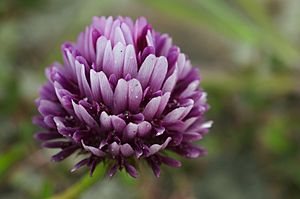Trifolium wormskioldii facts for kids
Quick facts for kids Trifolium wormskioldii |
|
|---|---|
 |
|
| Conservation status | |
| Scientific classification | |
| Genus: |
Trifolium
|
| Species: |
wormskioldii
|
| Synonyms | |
|
Lupinaster wormskioldii |
|
Trifolium wormskioldii is a species of clover. Its common names include cows clover, coast clover, sand clover, seaside clover, springbank clover, and Wormskjold's clover.
This plant is native to the western half of North America from Alaska, through California, to Mexico. It grows in many locales, from beaches to mountain ridges, below about 3,200 metres (10,500 ft) in elevation.
Habitats it grows in include chaparral, oak woodland, grassland, yellow pine forest, red fir forest, lodgepole forest, subalpine forest, and wetland−riparian
Description
Trifolium wormskioldii, a legume, is a perennial herb sometimes taking a matlike form, with decumbent or upright stems. The leaves are made up of leaflets measuring 1 to 3 centimeters long. The lower stipules are tipped with bristles and the upper stipules may be toothed.
The rounded inflorescences are 2 or 3 centimeter wide. The sepals are bristle-tipped. The corollas are pinkish purple or magenta with white tips.
Uses
Many Native American groups of western North America use this clover for food. The herbage and flowers are eaten raw, sometimes salted. The roots are commonly steamed or boiled and eaten with fish, fish eggs, and fish grease.
This species is host to the caterpillar of the Western cloudywing butterfly (Thorybes diversus).
Etymology
The species was given its scientific name in honour of the Danish botanist Morten Wormskjold.


